Today it is time for Douji, a.k.a. "The Douj" or "El Doujerino" where it has come to my attention that I should emphasise that the pronunciation of this brand is "DOH GEE", and not "DOO-GEE" as I recently heard to comic effect. Chinese is not a friendly language, but it is at least predictable and largely unambiguous. Yes, I still suck significantly (p < 0.05) when it comes to communication in Zhonglish.
With whopping great big piles of thanks to Mr. Jerry of China Chadao, this is the first half of a two-part tasting event. As with other recent events, I ordered my "inbox" and invited the first dozen souls to be participants. As before, if you, Gentle Reader, are one of those souls and happen to have found time to try the samples, please do append your comment below. If you have not found time, then, as always, fret not and enjoy them in your own time. This is tea, after all.
With whopping great big piles of thanks to Mr. Jerry of China Chadao, this is the first half of a two-part tasting event. As with other recent events, I ordered my "inbox" and invited the first dozen souls to be participants. As before, if you, Gentle Reader, are one of those souls and happen to have found time to try the samples, please do append your comment below. If you have not found time, then, as always, fret not and enjoy them in your own time. This is tea, after all.
The first thing that you will observe from the above photograph is that I was sent the original, unanonymised versions of these teas. Therefore, I am at a very slight advantage when it comes to guessing the origin of these samples.
We can also see that this "alpha" sample is none other than the weeny little Xiangdou [fragrant-Dou(ji)] brick. This is, traditionally, the least expensive of the Douji house blends, comprising maocha from Bulangshan (trousers), Menghai (darkness), and Manlushan (heaven knows - it is the Mengsong region of Menghai).
Douji does a nice range of "travel" teas, weirdly enough. For example, what should ordinarily be expected to be a crime against the senses, the Xiaojinzhuan [little golden brick] turned out to be really rather nice, despite being packaged as a series of "chocolate bar" squares. These little bricks are, likewise, often very drinkable.
It will be no surprise that the brick has suffered, in the usual manner of bricks (pictured above), from compaction and fragmentation - but such is the way of the brick.
The Xiangdou is deliciously sweet in its rugged, slightly rough way. It is a very decent baseline blend, demonstrating that an interesting patchwork can be created by careful selection of humble plantation leaves.
This Xiangdou is yellow, strong, sweet, and, as the name suggests, fragrant. I enjoy the heavy, dark-green Menghai base, the Bulangshan potency, and perhaps the sweet fragrance may be assigned to the remaining component in the blend: the Manlusha leaves. It is a mainstream, but most enjoyable, creation. By the fifth infusion, it is extremely ordinary, if it is possible to be ordinary in the extreme.
Working our way up the Douji food-chain...
The "Shangdou" could be roughly translated as "upper Dou(ji)", in the sense of a superior grade. Though there is nothing in the above photograph for scale, you can see that the weight (100g) makes this a xiaobing - it is actually rather tiny, although a wee bit bigger than the 75g brick shown previously.
Getting into your average Douji cake is like breaking into Fort Knox. You can't do it without significant collateral damage; in this case, it means shredding the wrapper while the big sticker (shown above) clings on for dear life. I have a lot of shredded Douji wrappers knocking around.
This "beta" sample looks really rather good, as you might agree from the photographs above and below. I could take a bite out of those dark, pretty, large leaves. There is a sweet grain-like aroma that promises much.
The presence of the granary-sweet scent of the dry leaves is explained when we find out that the blend contains general "Simao" leaves as well as Mengku-region leaves, in addition to the standard Douji base of general "Menghai" leaves.
This generic (and charming) Simao / Lincang character continues into the aroma of the wet leaves. It has a husky Simao flavour that is very satisfying, and which reminds me of some of the recent Yunnan Sourcing blends that I have enjoyed so much. There is some kuwei [good bitterness], but it remains, at heart, a mainstream tea. After four infusions, it has descended into standard green territory.
One step up the hierarchy comes the Dadou...
You know, by now, what to expect from the derriere of the cake; I leave you to imagine my helpless screams as I attempt to gain ingress.
This "gamma" sample is, as with many Douji cakes, very "easy on the eye":
The fragmented leaves have the sweet-green scent of 'Banna proper. The blend contains leaves from Manzhuan, Mengsong, and Youleshan, and so we are well embedded within the canonical tea area for this blend.
This is sweet and vivid, and I likes me it. Yes, it is plantation tea, but it manages pleasing hints of a tobacco base, with the evident darkness of Old 'Banna. It is a remarkably stable blend, not falling apart in any manner, which reminds of the skill of those generations of master blends responsible for the usual "English Breakfast" that my fellow Englishmen consume by the gallon, in the sense that it is utterly unchanging in its blend, with a consistency that is very difficult to achieve (as a blender). I totally love English Breakfast, by the way, despite it not being English, nor much to do with breakfast.
This is cake that is also very enjoyable when young or old, as will be seen in a moment...
"Thunder peals; I smile and drink my straightforward Dadou in peace."
The image below comes from my first encounter with Douji's common range of lower blends: a 2008 brick of Hongdadou. (Recall that, while most of these are the "red" blends - Hong - there sometimes may be found the "blue" blends - Lan - which are more potent, and aimed at storage.)
The "delta" sample is none other than the very same 2008 Hongdadou, provided by Jerry as a comparator for the 2012 "gamma". The amusing thing is, I can remember that session with the 2008 brick vividly - such are the mysteries of "flavour memory".
This cake has picked up the "south China" storage effect, which is pleasant - but perhaps a touch ubiquitous. If you've tried one mainstream 'Banna cake aged in south China, you can probably guess how this one turns out.
A core of sweetness remains in this tea, among all that malty redness that one would expect, but I am pleasantly surprised to find that some of the "creamy" sensation of the original 2008 brick, and which I can remember so clearly to this day, remains in the leaves. It is clean and fresh, if perhaps underpowered.
This makes for an interesting comparison with my own 2008 Dadou, which is much less "red malt" and much more "sharp pine". Both genres are very pleasant to me, but I must confess to being slightly more in love with the drier version (stored here in England) than this "delta" version - it feels as if the core has been burned out of the latter, while mine still retains some energy. As always, different strokes for different folks.
Thanks again to Mr. Jerry for the opportunity to get reacquainted with these constant and pleasing blends.







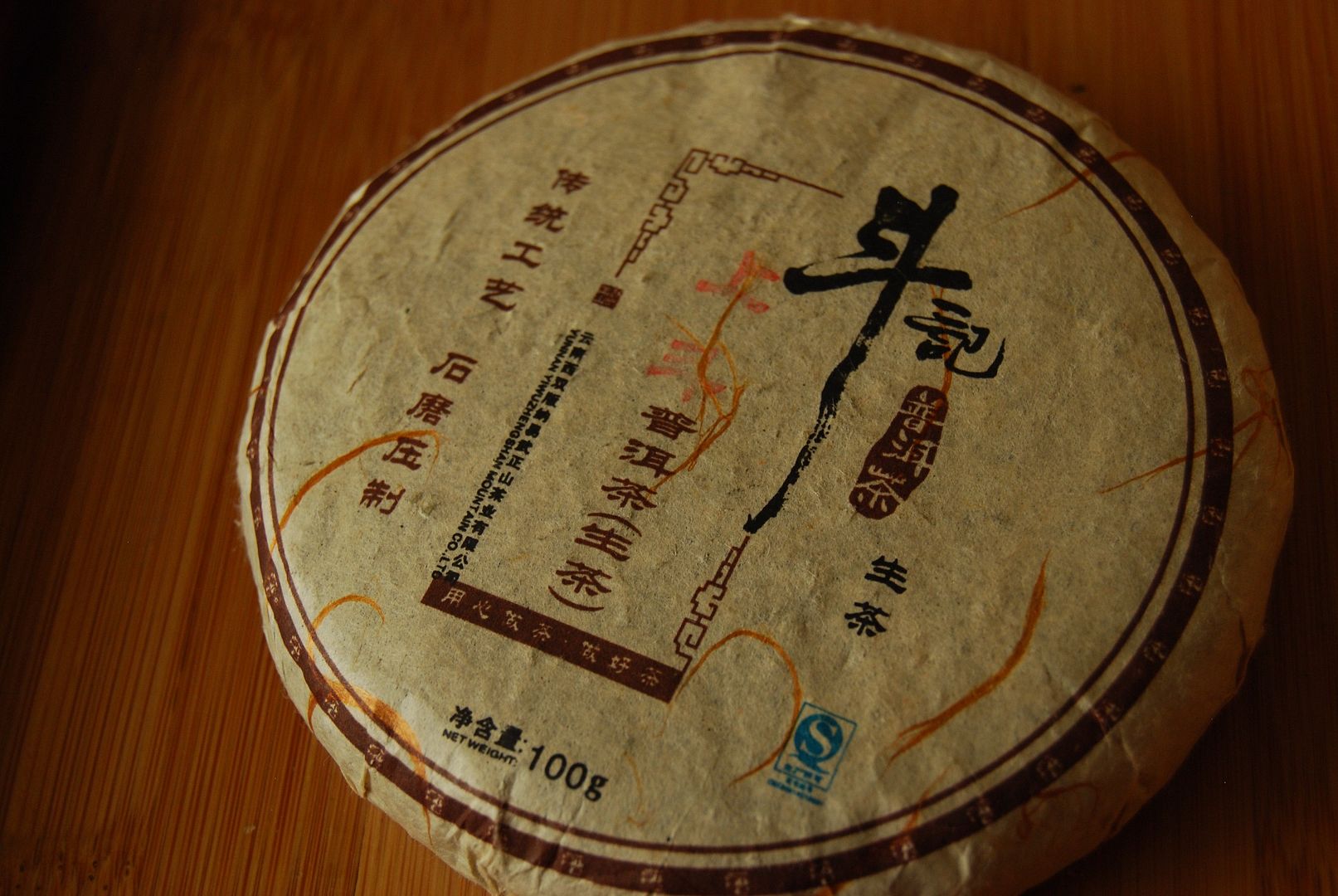




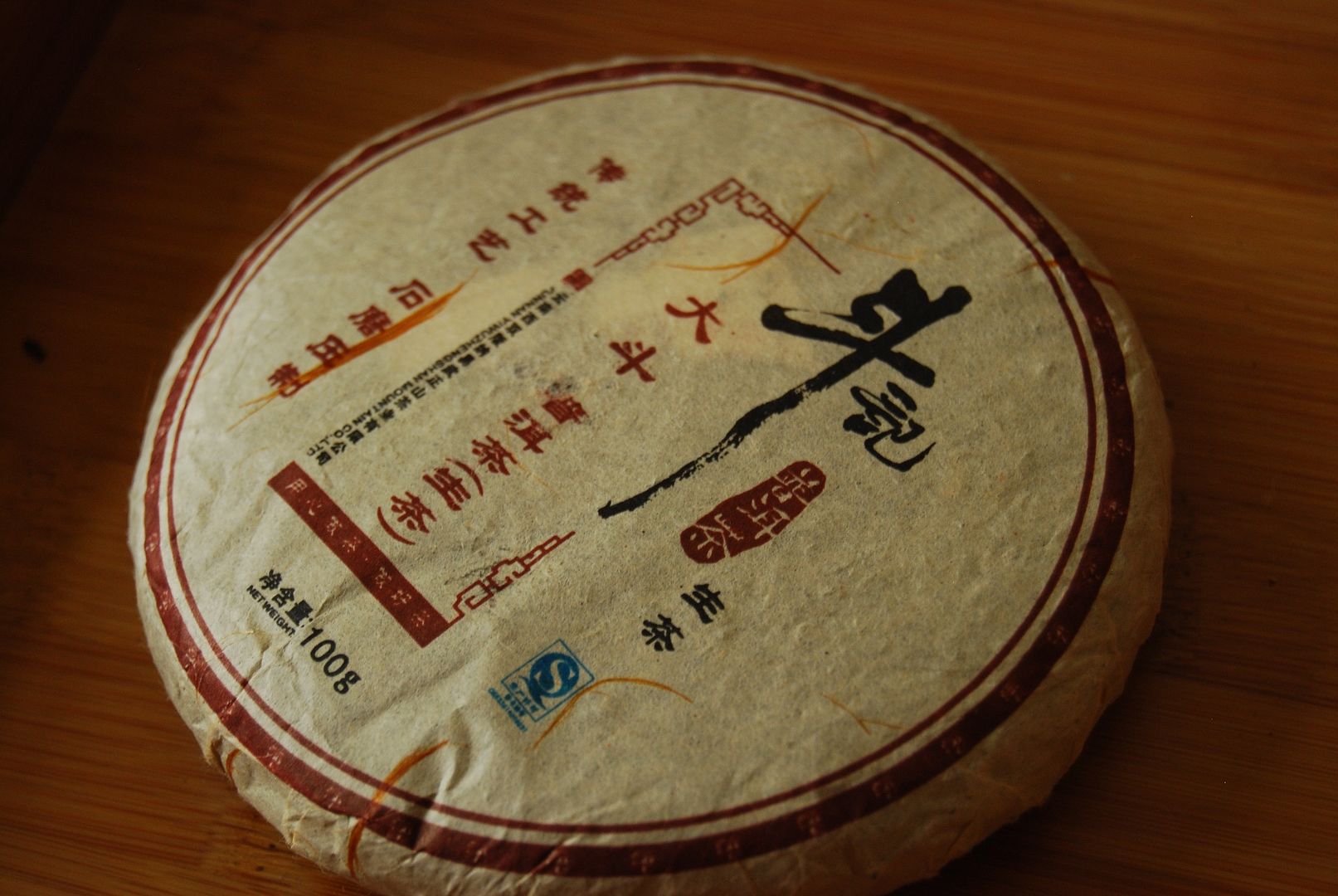

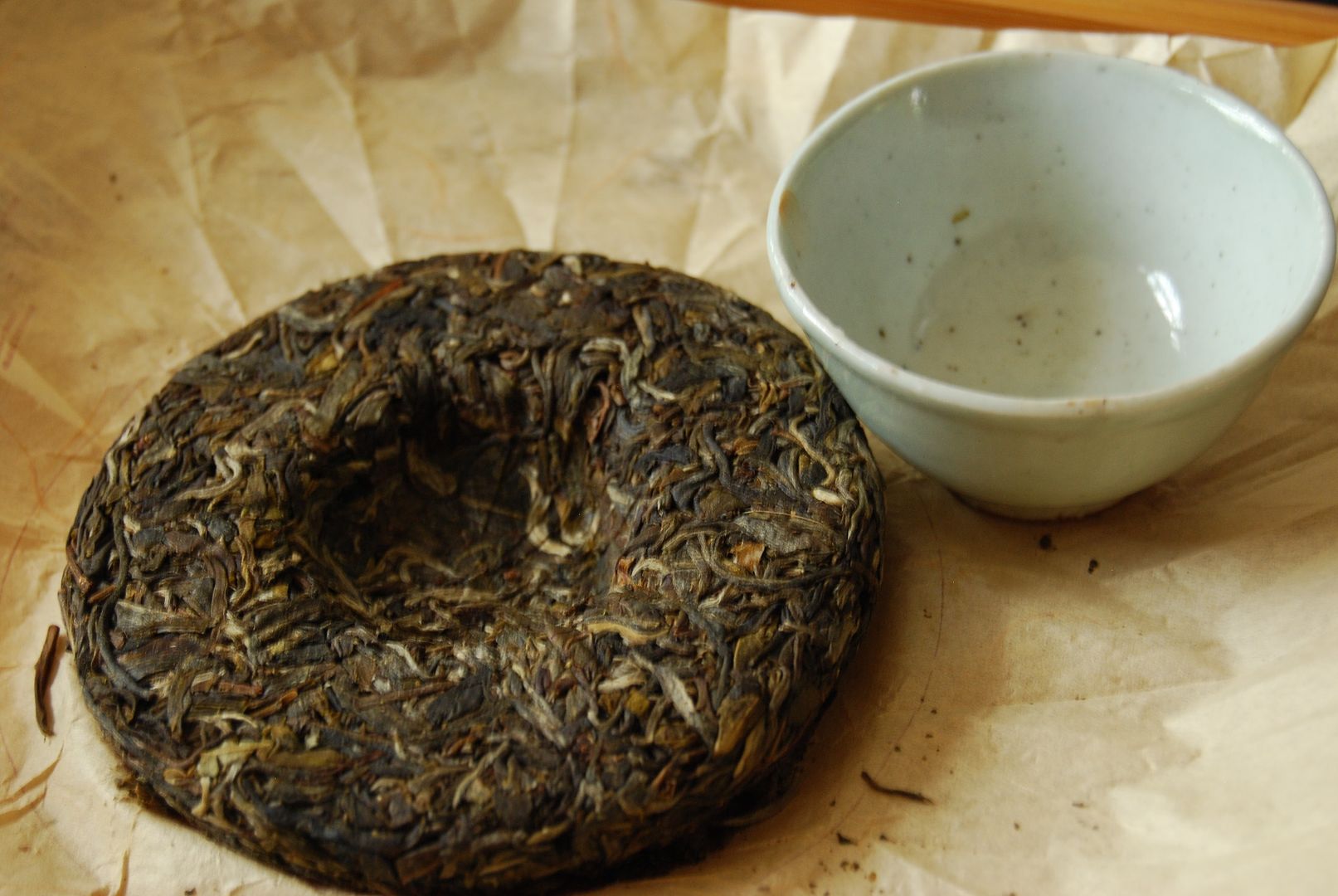
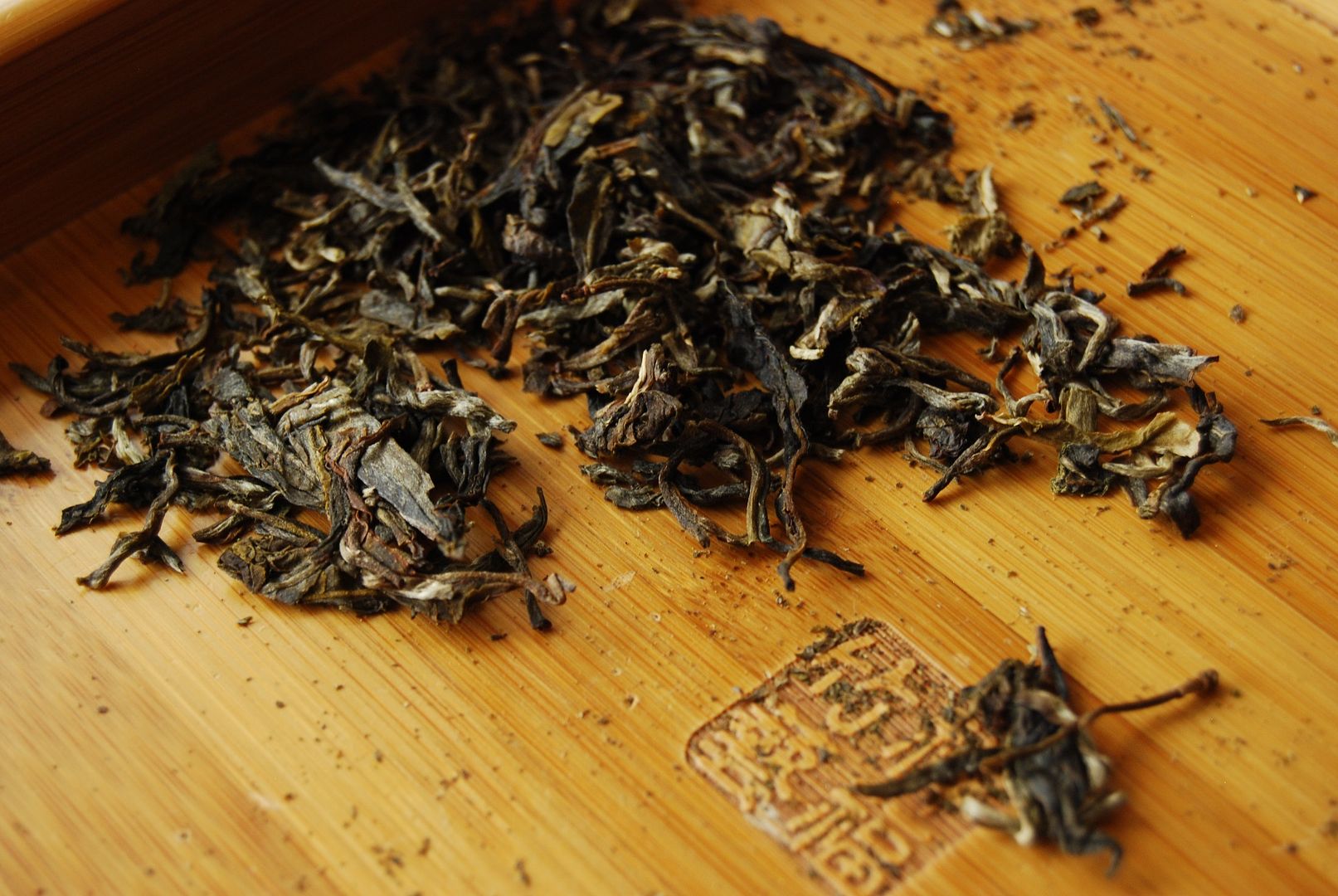
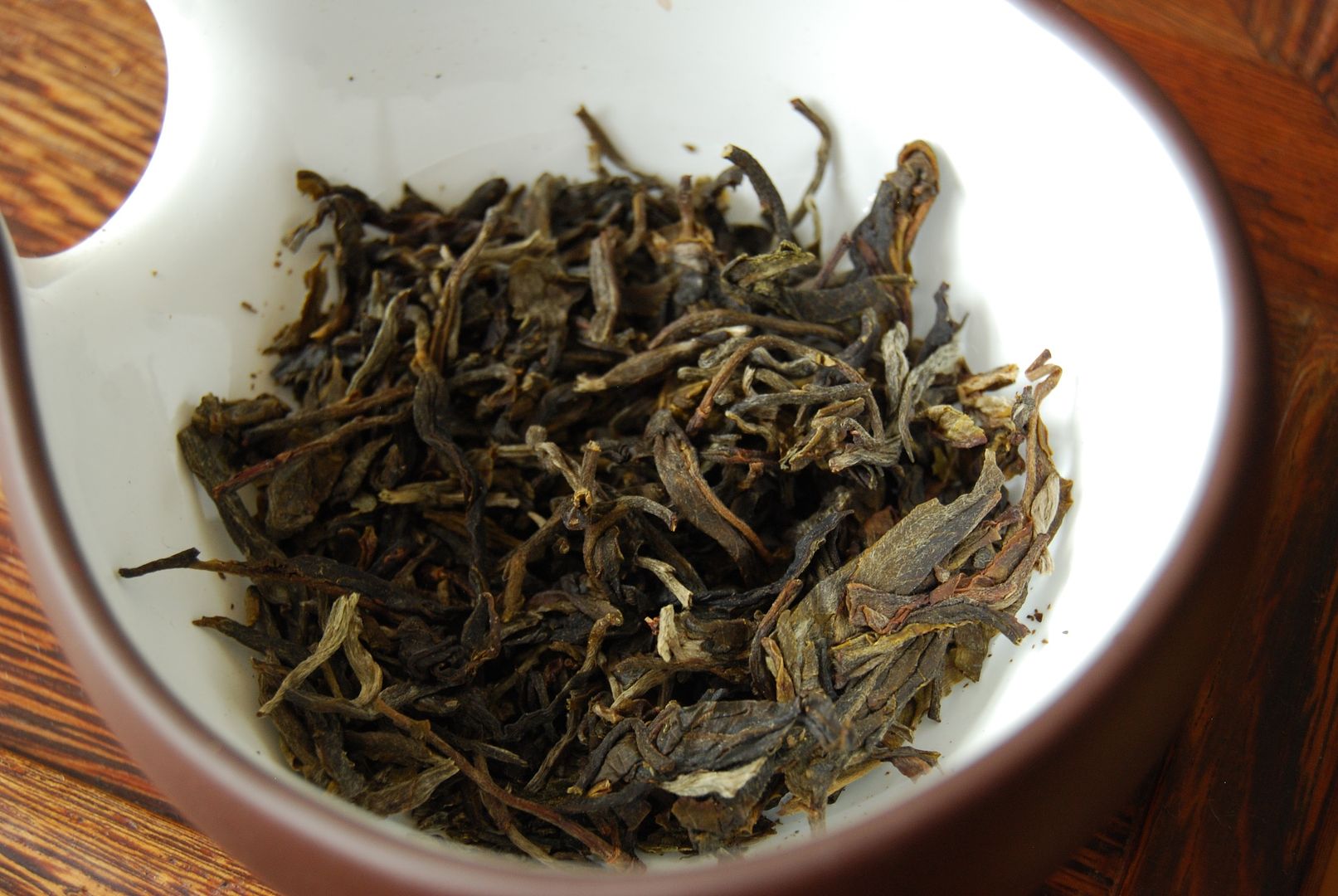


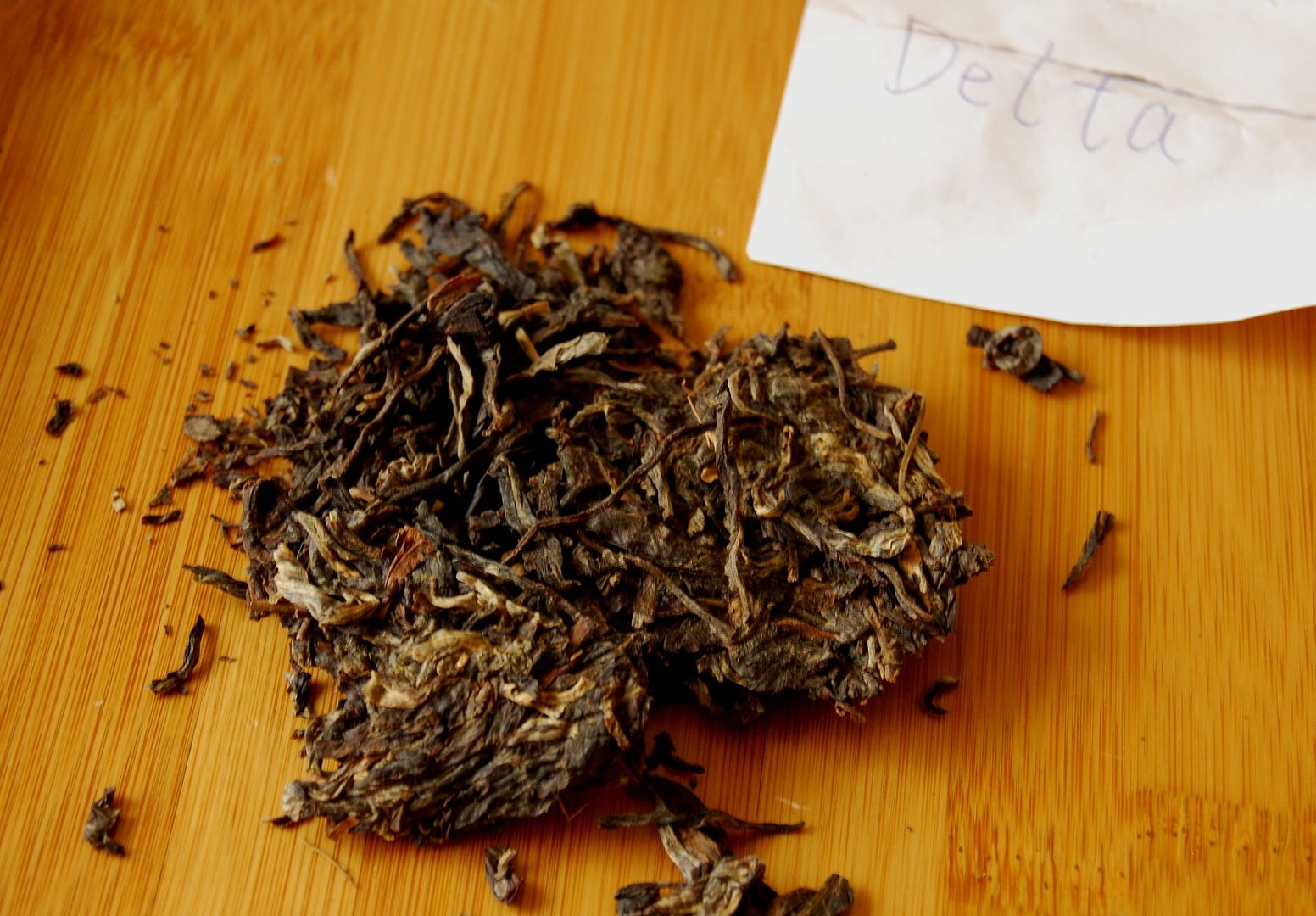
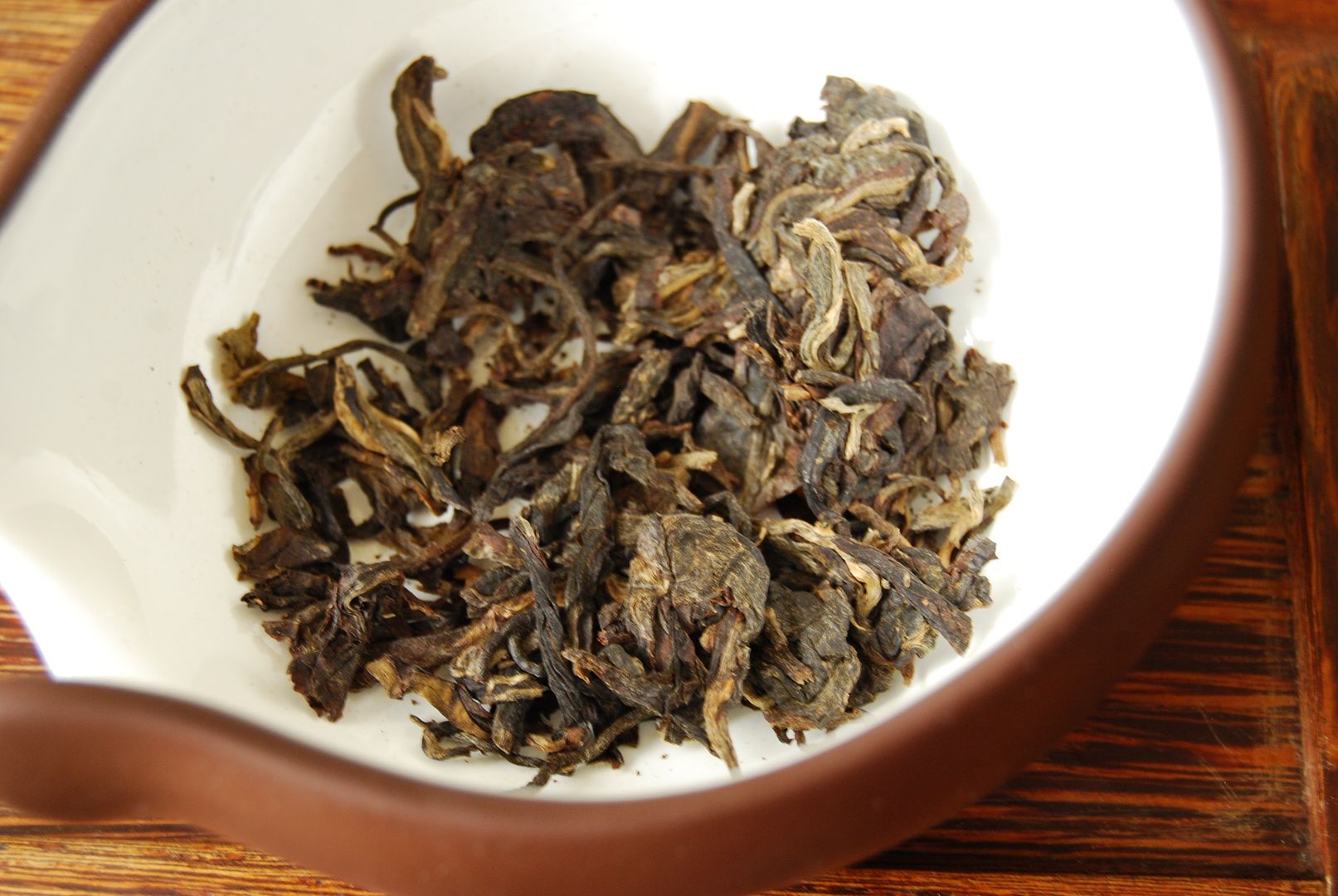
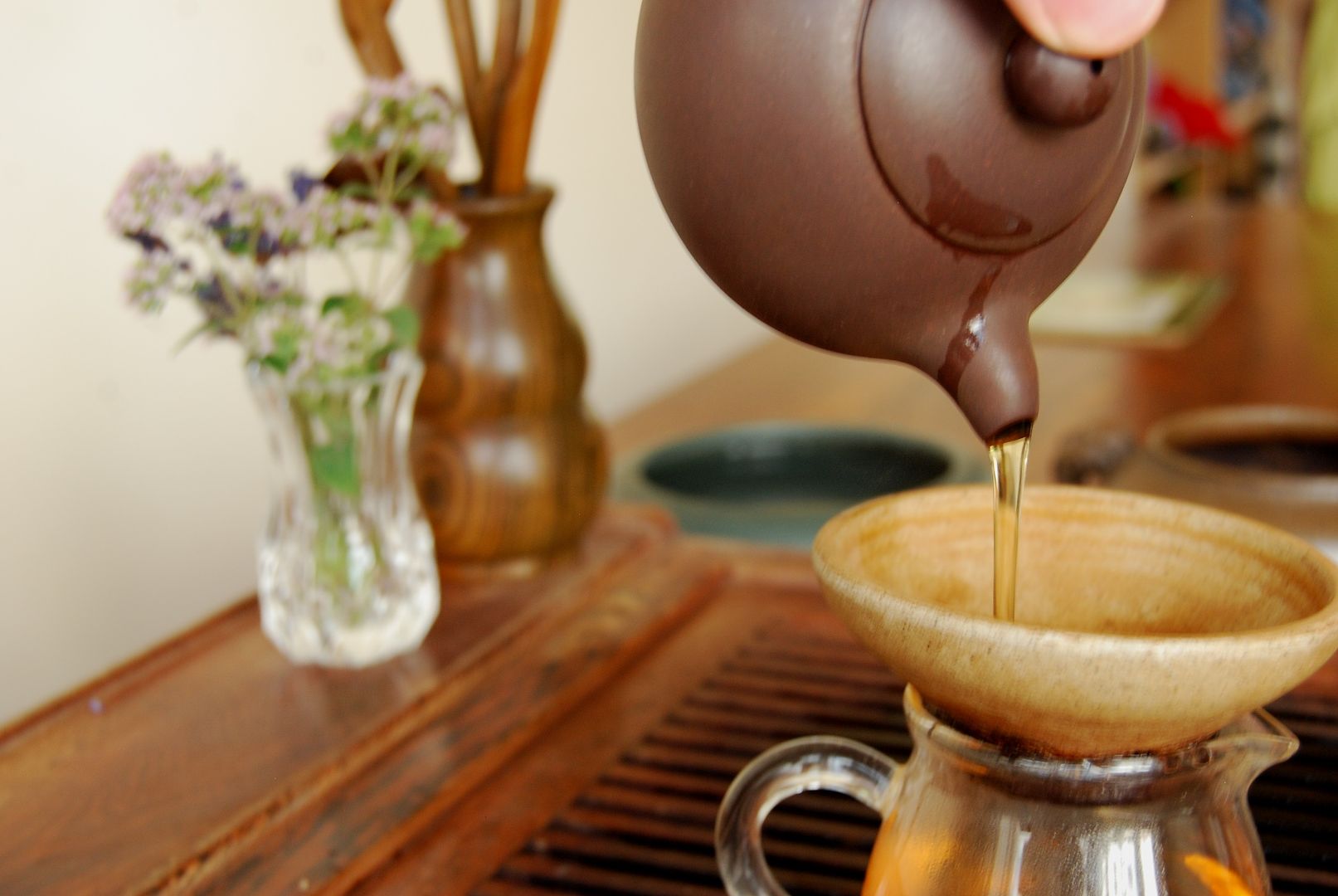
10 comments:
As you’ll see below, you must have done a good job dismantling Beta, the Shangdou xiaobing, because I was sure enough it was maocha that I didn’t even question…You’ll alsonote, with Gamma, that I blamed the oddball quantities of the samples on Chadao….(where’s that blushing emoticon?)
Alpha: Sweet hay, tightly compacted smallish green leaves. A stock production? Pale, yellow-amber soup. Florals on the pot lid with a hint of smoke in the background, much the same from the surface of the tea. Camphor. Almost no bitterness. Not much else to talk about?
Beta: Lightly roasted sweet grain aroma, maocha with medium sized leaves. Astray on the pot lid, deeply colored yellow-amber soup, strong ku greeting, more ash. Roasted grain flavor, not a lot of complexity.
Gamma: Sweet hay out of the bag. Low compression, smallish leaves, green and silver. Strong yellow soup, and a pleasing mixture of florals and smoke under the pot lid. Grain in the vapor, a raw and pervasive bitter as the first sip floods the mouth. I thought I was going to like this one, but I’m no longer sure. It tastes…?raw? sort of the way that mechanical grinding in a blender or food processor brings out harsh flavors from fresh herbs that would be better muddled or ground in a mortar. Could be because there was so much tea in the sample, and this is overbrewed in the sense of using too much tea, as opposed to too much time. The Chadao samples have been an awkward and variable quantity; mostly just enough for one good brew, but in this case too much for one, and too little for two, so I used the whole thing. As the infusions go on, this settles into something ordinary, but not unpleasant. Wish I hadn’t been so compulsive about using the whole sample, because I think I ruined what might have been a pretty good tea…
Delta: Small and dark “production style” dry leaf with not a lot of aroma. Nothing from under the lid of the pot either. A rather amber soup, this tea is not from last year, has at least several years of age to it. An ashy and mild ku greets, a light camphor spreads through the palate, but there isn’t much here. I’m thinking this might be a stock production, like maybe Dayi? There’s something of a dry grain aftertaste, almost like brown rice, and a late-developing, high-palate huigan. It’s ok, but wouldn’t go out of my way for it.
Many thanks, Carla!
Toodlepip,
Hobbes
Full Notes for these two on my blog
The Beta, I enjoyed quite a bit. I did not get that drop off into green territory. I stuck with the tea for awhile and it seemed to have quite a lot going on in comparison to some of the others. I did not guess it was Simao based.
The Zeta, seemed to me like Fall maocha that was processed similarly to black tea. Very floral, very red.
I did not realize a lot of these were blends, so when I took my notes I was trying with some consternation to peg an area. I did nail down the Mengsong in one blend, since the fragrance of that area is very familiar to me.
As I am checking my notes from last year, it seems that the prices for the 2010-2011 Douji cakes tripled or even quadrupled within 1 year, isn't that crazy?
Norbert
Thank'ee, Twodog!
Norbert, you're quite right - the prices have become silly. It is as if they are trying to ride the same wave as other labels that have attracted speculation.
Toodlepip,
Hobbes
Hi China Chadao Tasters,
Have tasted these four teas and will be posting them one a day for the next week.
Looking forward to comparing notes.
This is Alpha:
http://mattchasblog.blogspot.ca/2013/08/china-chadao-event-alpha-douji-xiangdou.html
Peace
Thanks, Matt - I trust that all is well. :)
Toodlepip,
Hobbes
Hobbes,
Things are better than well :)
Here is Beta:
http://mattchasblog.blogspot.com/2013/08/china-chadao-event-beta-douji-2013-hong.html
Peace
Thank you, sir!
I feel these teas have much more earthy, woody scents, whereas Scott's teas were much more floral and bright. On the whole, I found these to be slightly less interesting than the YS teas, however I also chose to brew these in yixing rather than porcelain.
Alpha - definite bitterness present; some mouthfeel and cooling/numbing sensations; 4th infusion had little/no activity up front, but had some huigan after effects in the back of the mouth and throat; thinned out by 5th infusion with little going on
Beta - less bitterness than Alpha; smooth throughout brews; thin then thicker in the mouth during 1st infusion; 4th infusion had graininess, beaniness, slight sweetness ... "smooth and pleasant but no discernible activity; enjoyed this more than Alpha"
Gamma - slightly bitter; pretty constant throughout ... "not bad to my tastes, but not entirely interesting either"; bitterness present throughout without major changes
Delta - underlying bitterness in 1st infusion, but not overpowering; touch of smokiness; amber-orange liquor; "barky/woody or piney"; slight activity in lower throat; smooth with some tanginess in the 2nd infusion; "herbal" taste throughout ... like oregano or sage or something; camphorous; not bitter necessarily, but strong "oregano taste" made it slightly unpleasant (reminded me of the Sigma from YS); unpleasant taste mellowed with 5th infusion ... more enjoyable
Overall, I enjoyed Beta the most. I really wanted to enjoy Delta (I enjoy aged sheng with some camphor to them), but the "oregano" just doesn't do it for me (as was the case with the Sigma from YS). Thanks again David and Jerry for making this happen ... always much appreciated.
Post a Comment